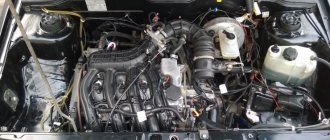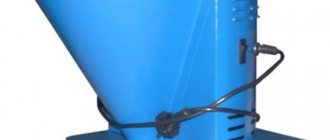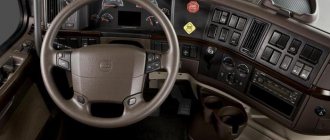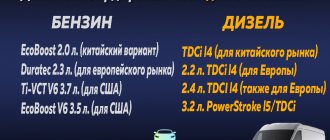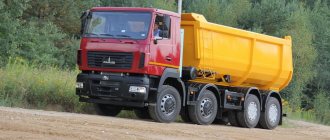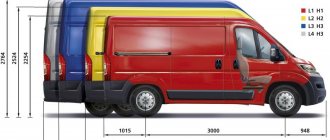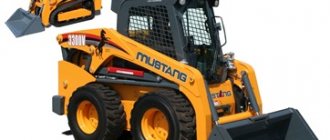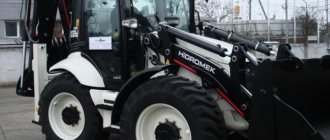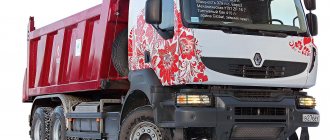This manual outlines the main design features of the engine and the requirements for its operation and care.
The instruction cannot serve as a theoretical teaching aid on a stationary small-displacement engine, therefore persons authorized to operate the Ulyanovets engine must have theoretical and practical knowledge of internal combustion engines and their operation.
Timely and accurate implementation of the rules for the care and operation of the engine given in this manual will ensure their trouble-free operation.
NOTE: Since the design of engines is continuously improved, some deviations from the drawings and text of these instructions are possible.
Please send all comments and suggestions regarding the instructions and operation of the engine to the following address: Ulyanovsk, 6, UMP OGK.
Purpose of the UD-2 engine
Before studying the technical characteristics of the UD2 engine in more detail, it is necessary to consider its type and purpose in more detail. It belongs to the category of multifunctional power units of a medium-boost type, which allows it to be used in a wide range of devices.
UD 2M was used in:
- various models of gas-electric units, generators;
- pumping equipment;
- compressor drives, winches and other mechanical components;
- motor boats for various purposes.
Mass production of the first copies of the UD began in 1952 at the motor plant in Ulyanovsk, when motors of three different modifications were manufactured. Over time, the line of power units was expanded in 1967 with two models at once.
The device is a 4-stroke type unit with valves located at the bottom of the product, with the exception of later modifications.
The service life of the engine with timely maintenance is extremely long, which allows it to still be used, especially in remote regions of the country. Proper ignition adjustment is of great importance, which allows you to successfully start the device even in low temperatures.
Technical characteristics of the UD-2 engine
Wanting to find out the features that the UD2 M1 engine has, as well as other modifications, it is advisable to study the performance indicators of this series of motors. They are almost identical for all modifications of this series and make the unit an optimal option for installation on various special equipment, as well as home-made devices.
Main technical characteristics of UD-2:
- product volume - 610 cm3;
- power - 8 hp;
- number of cylinders - 2, diameter 7.2 cm;
- lubrication system - combined;
- recommended type of oil - mineral;
- cooling system - forced, air type;
- fuel supply - carburetor;
- dimensions (LxWxH) - 55x48.5x55.5 cm;
- type of fuel consumed - unleaded A-72; A-76;
- product weight - 72 kg.
Thanks to the low level of fuel consumption, which is about 370 g/hp. per hour, the cost of operating the equipment is extremely economical. At the same time, the light weight of the unit and the abundance of spare parts allow you to significantly save on maintenance and repairs by performing the necessary work yourself.
Rebuilding the engine is not very popular among owners, since it has optimal characteristics. Much more often, “Ulyanovets” is used as a power unit for assembling various homemade types of special equipment - tractors, walk-behind tractors, cultivators.
UD-2 engine design
As numerous reviews from owners of such a device show, it is distinguished by a simple, reliable design that can last for many years with proper care. The main element of the engine is the crankcase, the components of which are 2 housing parts.
Other important components include:
- crank mechanism installed in the crankcase;
- piston group;
- crankshaft;
- flywheel.
It should be noted that in the manufacture of parts of this power unit, 2 materials were used at once. For elements that are more susceptible to wear, cast iron was chosen as the material of manufacture, and for other less critical parts, aluminum alloy was chosen. This made it possible to reduce the weight of the unit and also increase its service life.
Homemade equipment
Enter the site
Latest articles
- Homemade all-terrain vehicle "Terbunych"
- Welding machine from a car generator
- Engine UD2
- Homemade buggy
- Homemade caterpillar
| Engine UD2 |
| 11.01.15 21:35 |
Many home-made workers, before starting to design a home-made mini tractor, usually think about what kind of engine to put on it. Previously, in the era of the USSR, the most popular engine for home-made people was the UD 2 engine. Nowadays it is considered outdated, but still it has not lost its fans and many novice home-made tractors prefer to install the UD 2 engine on their home-made tractors. UD is a brand of multi-purpose stationary small-displacement internal combustion engines produced by the Ulyanovsk Motor Plant. The letters UD in the engine name stand for Ulyanovsk Engine. All engines of the UD series were produced as four-stroke air-cooled engines. Since 1952, the Ulyanovsk plant has produced 3 models of UD series engines: UD1 is a single-cylinder engine, 305 cc, 4 hp. with bottom valves; UD2 - two-cylinder engine, volume 610 cc, power 8 hp. with bottom valves; UD4 - four-cylinder engine, volume 1220 cc, power 15 hp. with bottom valves; The same engines were also produced by other factories under the brands PD (Petropavlovsk), SK (Kazakhstan), SM (Kharkov). The UD2 engine is a medium-boosted carburetor engine with a specific weight of about 9 kg/hp, which at one time was a normal indicator, although by today’s standards this is already a bit much for a stationary engine. The design of the UD2 engine is designed for continuous operation at the rated output power under difficult operating conditions (low or high air temperatures). The engine life before major overhaul is about 3000 hours. Naturally, UD 2 engines are not without their shortcomings, which many craftsmen have learned to successfully combat by installing other carburetors, contactless ignition, etc. Here are a few videos with converted UD 2 engines: Video UD 2 engine with contactless ignition system Video UD 2 engine with carburetor from Jupiter |
Modifications of the UD-2 engine
During the production of this legendary domestic engine, the Ulyanovsk plant produced 4 main modifications. They differ from each other in power indicators, as well as design features:
- UD2S-M1 - equipped with a RO-1 gearbox;
- UD2T-M1 - distinguished by the presence of an 8-liter fuel tank;
- UD2ST-M1 - provides for the presence of a gearbox and a fuel tank.
It is necessary to mention the modification UD2-1MS, which was distinguished by the presence of an electric starter. It made it possible to make the engine start much more confident, thanks to which this modification was used in army equipment.
Total information
In 1967, the range of engines was expanded with units based on ZAZ-966 engines. One of the engines based on the Zaporozhets engine was the single-cylinder four-stroke UD-15. With a cylinder displacement of only 0.245 liters, the engine power is 6.5 horsepower at 3600 crankshaft revolutions. This power is achieved with the carburetor throttle fully open. In practice, the UD-15 engine operates under the control of a rev limiter and develops a long-term power of no more than 4 forces. The photo below shows a generator station with a single-cylinder engine.
The second engine of the new family was the larger two-cylinder UD-25. The engine, with a working volume of 0.490 liters, has a long-term power of about 8 horsepower. Structurally, the UD-25 engine is maximally unified with its single-cylinder counterpart. One of the features of the engines was the camshaft drive scheme, in which the gears are located directly inside the crankcase. The photo below shows a two-cylinder UD-25.
Both engines have a low compression ratio (6 and 7 units, respectively) and can run on gasoline with an octane rating of at least A72. According to the operating instructions for the UD 15 engine, the unit has the following overall dimensions and weight:
Engine UD2 technical specifications
Multifunctional medium-boosted UD engines, produced by the Ulyanovsk Motor Plant (the abbreviation UD stands for “Ulyanovsk Engine”) since 1952, were used to drive various small-scale mechanization equipment, as well as in gasoline-electric units of the AB type. In general, the UD engine is a classic four-stroke air-cooled gasoline engine. Initially (1952), the plant mastered the serial production of three modifications with a lower valve arrangement:
- UD-1 is a single-cylinder power unit with a cylinder capacity of 305 cubic meters. cm, developing a power of 4 l. With.;
- UD-2 - 2-cylinder engine, the power of which was 8 liters. With. (cylinder volume 610 cm3);
- UD-4 is a four-cylinder engine with a cylinder capacity of 1220 cc. cm. It developed a power of about 15 hp. With.
Then (1967) more modern power units with overhead valves were launched into production:
- single-cylinder UD 15 (power 6 hp);
- two-cylinder UD 25 (power 12 hp).
Depending on the purpose, the UD series motor was equipped with a variety of attachments, among which one could find:
- Electric starter.
- Reverse gearbox.
- Flange for connecting gearbox, etc.
Modifications
All stationary UD units are available in various versions, differing in attachments. The UD-15 engine, which was supplied to customers in the basic version and in the version with the index “G” for driving an electric generator, was no exception. The photo below shows this version of the motor.
The generator version of the engine was distinguished by an adapter bell mounted on the crankcase for mounting the generator and the presence of a ring gear on the flywheel. To start such a unit, an ST-351V electric starter with a voltage of 12 V was used. Another difference between the versions was the spark plugs. The UD-15 engine uses a spark plug model A10N or CH200, and the UD-15G generator motor uses a spark plug CH302-A.
Malfunctions
UD power units are characterized by a number of typical defects (see table).
| FAULT | CAUSE |
| Starting the engine is difficult or impossible. | Defects in the fuel supply system; The ignition system is faulty. |
| The engine does not develop the required power. | Ignition adjustment is broken; the jet is clogged; timing valve clearances are broken; The tightness of the gas pipeline is broken. |
| Extraneous knocking noise in the engine. | The ignition timing is incorrectly set; the presence of carbon deposits in the combustion chambers; the flywheel has become loose; parts of the connecting rod and piston group are worn out. |
| The engine gets very hot. | The ignition is not adjusted; the motor is overloaded. |
| Compression in the cylinders has decreased. | Wear of piston rings; timing valve clearances are broken; The cylinder head gasket was blown. |
Carter
The main part of the UD-15 engine is the aluminum crankcase with a tunnel design. It houses a separate front crankshaft bearing housing that is bolted on. In the front wall of the crankcase there is space for installing a gear pump and a pressure reducing valve for regulating the pressure in the lubrication system. On the outer side of the crankcase there is an axis for the foot pedal to start the engine.
The design of the engine crankcase provides a ventilation system through a special valve located near the magneto drive. The gases that break into the crankcase enter the rubber pipeline through the valve and then into the engine air filter.
Description
The UD 2 engine is a 4-stroke power unit with a bottom valve arrangement.
The basic element of the engine is the crankcase, consisting of two body parts connected to each other. Inside it are installed parts of a crank mechanism that converts the reciprocating movement of the pistons into the rotational movement of a solid forged crankshaft. The connecting elements between the pistons and the crankshaft are solid forged connecting rods, which have an I-beam cross-section. Each of them is connected to the corresponding piston by a special piston pin. The piston walls have grooves in which one oil scraper ring and two compression rings are installed.
Critical parts of the mechanism were made from:
A heavy flywheel mounted on the front extension of the shaft facilitates the removal of the connecting rod and piston group from the “dead spots” and, in addition, ensures the supply of cooling air to the cylinder head and directly to the cylinders. For this purpose, it is equipped with figured blades. The external drive coupling is installed on the rear side of the shaft.
The carburetor, fuel tank and air filter are mounted on the outer surfaces of the crankcase. Gasoline enters the carburetor by gravity from the tank, and the air filter cleans the air that enters the cylinders from dust. The crankshaft speed is controlled by a centrifugal governor, which controls the carburetor throttle valve.
Maintenance
UD engines, like any other internal combustion engines, require regular maintenance (MOT). In this case, they distinguish:
Shift maintenance comes down to checking before each start of the power unit:
After starting the engine, you need to check the engine oil pressure and make sure there are no extraneous sounds or knocks inside the engine. At the end of the work, it is necessary to drain the contents of the fuel tank sump.
The first maintenance is carried out after the first 50 hours of engine operation. In this case it is necessary:
- change the air filter;
- change the oil filter element;
- change the engine oil;
- wipe the timing valve;
- clean the combustion chambers and pistons from carbon deposits;
- check timing valve clearances;
- check the contact gaps in the spark plugs;
- Clean magneto contacts.
In the future, these procedures (TO-2) are recommended to be carried out every hundred hours of operation. In addition, it is recommended to regularly clean the crankshaft of sediment accumulated in the connecting rod journals.
Engine shafts and pistons
One of the main characteristics of engines is the use of ball bearings as crankshaft supports. The front bearing is installed in a removable housing, and the rear bearing is pressed directly into the engine crankcase. This design made it possible to increase the service life of the engine and significantly simplified repair work.
On the front of the shaft there is a so-called “lube bearing” that distributes the oil supply from the pump. In addition, a camshaft drive gear and a flywheel are mounted at the front end of the shaft. The other end of the shaft has the shape of a cone, onto which a coupling is installed to drive the units.
The camshaft is mounted on bushings made of bronze tape. The valves located in the heads are driven using rods and rocker arms. The photo clearly shows the valve cover and engine head.
The UD-15 design uses aluminum pistons with two compression rings and one oil scraper ring. The design of the pistons uses a specially shaped skirt, which minimizes the risk of sticking when heated. Each cylinder has its own cast iron with developed external fins. The inner surface of the cylinder plays the role of a mirror.
Mixing formation
To power the UD-15 engine, a K-16M or K-45M carburetor is used (on an engine with 2 cylinders). The design of the carburetor allows it to be used in conjunction with a speed controller. Speed regulation is carried out by two spring-loaded balancers. As the speed increases, centrifugal force pushes these balancers apart to a certain point. When it is reached, the balancers begin to move the carburetor throttle valve through the rod, thereby reducing the speed. The governor springs can change the tension force to set the speed.
To supply gasoline from the tank, a diaphragm fuel pump is installed on the engine crankcase. The working drive of the pump is realized from a separate cam on the engine camshaft. A manual drive is provided to pump gasoline into the carburetor when starting. Air filtration is carried out by an inertia filter with an oil bath.
Lubrication
The lubrication system of the UD-15 and UD-25 engines is identical. The lower part of the engine crankcase is used to store an oil reserve of 1.5 liters (3 liters for a two-cylinder engine). From there it is fed under pressure to the engine bearings and into a centrifuge for cleaning. Purified oil is supplied to lubricate the connecting rod bearings and the gas distribution mechanism. In this case, oil is supplied to the engine valve boxes through the drive rod of one of the valves. The oil drains back from the box through a separate tube. For use in engines, the cheapest mineral oils of summer and winter grades can be used.
There is a mechanical indicator to control the oil pressure. The normal pressure is considered to be a protrusion of the indicator rod of 3 mm. Optionally, a dial pressure gauge MTS-16U can be installed on the engines. There is a hole in the crankcase for its installation, closed with a screw plug. This hole is used to fill in fresh oil. For drainage there is a second plug on the bottom of the engine crankcase.
Specifications
During Soviet times, UD 2 was the most popular power unit among craftsmen who were able to independently assemble a mini-tractor, motorboat, etc. Its operational and technical parameters are shown in the table.
| OPTIONS | MEANING |
| Power, l. With. | 8 |
| Cylinder volume, cm cubic. | 610 |
| Number of cylinders | 2 |
| Cylinder diameter, mm | 72 |
| Piston stroke, mm | 75 |
| Compression ratio | 5.5 |
| Lubrication system | Combined (spraying + under pressure) |
| Oil | Mineral |
| Volume of engine oil to be filled, l | 4 |
| Cooling system | Air, forced |
| Fuel supply system | Carburetor |
| Carburetor type | K-16V |
| Fuel | Unleaded gasoline A-72, A-76 |
| Specific fuel consumption, g/l. With. hour | 370 |
| Ignition system | Forced (high voltage magneto) |
| Magneto type | M-68B1 right rotation |
| Spark plug | A 10 N |
| Dimensions length/width/height, mm | 550/485/555 |
| Weight, kg | 72 |
| Motor resource, hour | 3000 |
Engine UD 25 - UD 15 characteristics, operating instructions
Engine UD 25 and UD 15 - characteristics, operating instructions
Engines UD 25 and UD 15 were produced many years ago, but are still used by fans of such equipment. Despite the fact that they are already decades old, they serve their owners faithfully. Such engines were used to drive electric power units and mobile power plants, various agricultural, construction and road machines, including MTZ walk-behind tractors, often used on homemade mini tractors.
Stationary small-displacement engines UD-15, UD-25 and their modifications are designed on the basis of the engine model MEMZ-966 (965) of the Zaporozhets car. The UD-15 engine is single-cylinder, and the UD-25 is two-cylinder. Both UD models are made according to the same design scheme and are as unified as possible.
Technical characteristics of the UD 25 and UD 15 engines
| Model UD - 15 (SK-6) | Model UD -25 (SK-12) | |
| engine's type | four-stroke carburetor | |
| Number of cylinders | 1 | 2 |
| Power (at wide open throttle), hp at 3600 rpm at 3000 rpm | 6 5 | 12 10 |
| Nominal engine speed, rpm | 3000 | 3000 |
| Rated power, operational (long-term) at the regulator, l. With | 4 | 8 |
| Specific fuel consumption at rated operating power, g/l. s h | 330 | 320 |
| Cylinder diameter, mm | 72 | 72 |
| Piston stroke, mm | 60 | |
| Working volume, cm 3 | 245 | 490 |
| Compression ratio | 6 | 6 |
| Valve location | top | |
| Adjustment gap between valves and rocker arms (on a cold engine), mm | 0,15 | |
| Fuel | gasoline A-72 GOST 2084-67 | |
| Fuel supply | diaphragm type fuel pump | |
| Carburetor | K-16M (K45M) | |
| Air filter | inertia-oil with filter element | |
| Air filter oil bath capacity, l | 0,074 | |
| Oil: in summer (above +5°C) | diesel Dp-11 GOST 5304-54; diesel DS-11 (M10B) GOST 8581-63; automobile AS-10 (M10B) GOST 10541-63 | |
| Oil in winter (below +5°C) | diesel Dp-8 GOST 5304-54; automobile AS-8 (M8B) GOST 10541-63 | |
| Engine lubrication | combined, camshaft connecting rod bearings and valve lifters are lubricated under pressure | |
| Oil purification | part-flow centrifuge | |
| Oil pump | gear | |
| Operating oil pressure, kg/cm2 | 1,5-5 | |
| Pressure control | rod indicator | |
| Oil tank capacity, l | 1,5 | 3 |
| Engine oil consumption (for topping up), g/l, s.h. | no more than 10 | |
| Magneto | M-137 | M-151 |
| Ignition timing to TDC | 33°±1° | |
| Candle | A-11U (SN-200) GOST 2043-54 or CH-302A | |
| Cooling type | air forced | |
| Regulating the flow of cooling air | louvers on flywheel housing | |
| Launch | lever mechanism | |
| Speed control | automatic centrifugal speed controller | |
| Connection to slave unit | by means of an elastic intermediate coupling element | |
| Overall dimensions, mm: length width height | 410 455 535 | 530 455 564 |
| Weight, kg | 41 | 52 |
Ignition and starting
The UD-15 engine is equipped with an ignition system from a conventional single-spark magneto M-137 (double-spark M-151 on the UD-25). The design of the unit ensures constant regulation of the angle of the spark supply to the engine spark plug. All magneto components are located in a zinc alloy housing. The drive is carried out from the speed control gear using an additional clutch.
The conventional UD-15 engine is started using a kick starter pedal. The kick starter is a lever with a toothed sector that meshes with a gear on the crankshaft flywheel shaft. This gear is equipped with a ratcheting mechanism that disengages it after the engine starts. The return motion of the starter pedal is ensured by a spring.
Upgraded UD 2M engines
As a result of numerous modernizations that were carried out in the late nineties of the last century, an additional prefix “M” appeared in the marking of power units. Engine UD 2 modernization: now the modern basic design is designated UD2-M1. There are several versions of UD 2M engines; their design and technical characteristics have received some changes:
- The UD2S-M1 power unit includes a fuel tank with a capacity of 20 liters and a RO-1 gearbox.
- The UD2T-M1 engine has an eight-liter fuel tank, which is located on top of the body. The filled amount of gasoline is enough for continuous operation for one and a half hours.
- The UD2ST-M1 power unit has the same fuel tank, in addition it includes RO-1.
Tuning
The UD 2 power unit, in the opinion of many owners, is quite capricious during operation. Therefore, it is quite often subjected to various modifications, which, by and large, can hardly be called tuning. However, they add stability and reliability to its work. The following modifications are most often carried out:
- reduce the volume of combustion chambers;
- rework the intake manifold;
- modify the lubrication system, making it full-flow;
- The magneto is modified by replacing the high-voltage coil with an ignition coil from a car.
Application today
Stationary UD-15 engines were widely used on various agricultural machinery, for example, on the MTZ-05 walk-behind tractor. In addition to Ulyanovsk, motors were assembled at factories in Petropavlovsk (Kazakh SSR) under the designation PD or SK and in Kherson - under the designation SM.
Currently, engines are quite widely used on homemade equipment - tractors and motor boats. The photo below shows a homemade walk-behind tractor.
Reviews about the UD-15 engine are mostly positive. One of the main conditions for trouble-free operation of the engine is timely and regular maintenance by cleaning the engine fins from dirt. The only drawback is the lack of high-quality spare parts, so many engines are dismantled for donor parts.
Source
Advantages of using gasoline power plants
Despite the development of modern electrical technology, generators produced to meet the needs of the army are distinguished by their reliability and breadth of application. It is possible to use such generators in various areas of human activity:
- conducting military exercises and maneuvers;
- disaster relief;
- tourism;
- lighting of car parks or garage cooperatives;
- energy supply for aviation units.
Despite their undeniable advantages, gasoline power plants are inferior to other units used to generate electrical energy. A diesel military power plant, the characteristics of which are practically no different from gasoline varieties, has a large number of advantages. The most important advantage is efficiency with high power output. Diesel fuel is cheaper than gasoline and safer from a fire safety point of view. Some modifications of electric generators running on diesel fuel are capable of producing up to 100 kW of energy, which is quite enough to illuminate a tent camp.
To summarize, it can be noted that, regardless of the type of fuel consumed, army power plants are trouble-free and reliable units that will serve faithfully for a long time without serious breakdowns.
If you find an error, please select a piece of text and press Ctrl+Enter.
